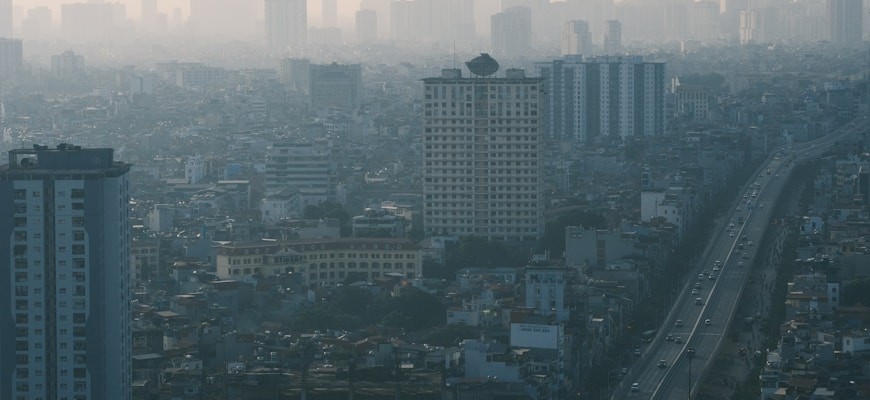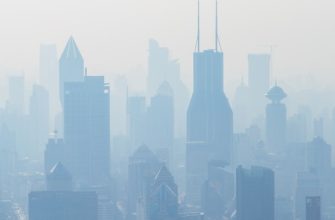- Understanding the Sources of Urban Air Pollution
- The Health Risks of Poor Air Quality in Cities
- Practical Tips for Reducing Exposure to Air Pollution
- Indoor Air Quality: Creating a Safe Haven at Home
- The Role of Urban Planning in Combatting Air Pollution
- Advocating for Cleaner Air: How You Can Make a Difference
Understanding the Sources of Urban Air Pollution
Urban air pollution poses significant health risks, making it essential to understand its primary sources. The complexity of urban environments contributes to a variety of pollutants that can negatively impact respiratory health, cardiovascular systems, and overall well-being.
- Vehicle Emissions: One of the leading contributors to urban air pollution is emissions from automobiles, trucks, and buses. These vehicles release nitrogen oxides, carbon monoxide, and particulate matter, all of which degrade air quality.
- Industrial Discharges: Factories and manufacturing plants often emit volatile organic compounds (VOCs) and other harmful chemicals into the atmosphere. These substances can exacerbate respiratory issues and lead to long-term health problems.
- Construction Activities: Dust and particulate matter generated during construction or demolition work significantly contribute to air pollution. This not only affects the immediate area but can also spread to surrounding neighborhoods.
- Household Products: Common household items such as paints, cleaners, and aerosols release VOCs that contribute to indoor and outdoor air pollution. Reducing the use of these products can improve air quality.
- Agricultural Activities: In urban areas near farmland, the use of pesticides and fertilizers can lead to air pollution. These chemicals can become airborne and affect urban populations.
Understanding these sources is crucial for developing effective strategies to mitigate urban air pollution and protect health. Community awareness and action can significantly reduce exposure to harmful pollutants, leading to a healthier urban environment.
The Health Risks of Poor Air Quality in Cities
Air pollution poses significant health risks, particularly in urban environments where the concentration of harmful pollutants is often elevated. Exposure to poor air quality can lead to a variety of health issues, affecting both short-term and long-term well-being.
- Respiratory Problems: Prolonged exposure to polluted air can trigger respiratory diseases such as asthma, chronic bronchitis, and even lung cancer. Fine particulate matter (PM2.5) is especially harmful, as it can penetrate deep into the lungs.
- Cardiovascular Issues: Studies have shown a strong link between poor air quality and increased risks of heart attacks and strokes. Pollutants can cause inflammation in the cardiovascular system, leading to serious health complications.
- Neurological Effects: Emerging research suggests that air pollution may also impact brain health, contributing to cognitive decline and increasing the risk of neurodegenerative diseases like Alzheimer’s.
- Reproductive Health: Pregnant women exposed to high levels of air pollution may face complications, including low birth weight and preterm births. The effects of toxins can extend to the developing fetus.
- Impact on Children: Children are particularly vulnerable to the effects of air pollution, which can hinder their lung development and increase susceptibility to respiratory infections.
Mitigating the effects of air pollution is crucial for maintaining health in urban areas. Individuals can take proactive steps such as using air purifiers indoors, wearing masks outdoors, and reducing vehicular emissions to help improve air quality.
Understanding the health risks associated with poor air quality is essential for urban residents. By recognizing these dangers, individuals can make informed decisions and adopt strategies to protect their health against air pollution.
Practical Tips for Reducing Exposure to Air Pollution
Reducing exposure to air pollution is essential for maintaining good health, especially in urban environments where pollution levels can be high. Implementing practical strategies can significantly decrease the risks associated with poor air quality.
- Stay Informed: Regularly check air quality indexes in the city. Various mobile applications and websites provide real-time data on pollution levels, allowing individuals to plan outdoor activities accordingly.
- Limit Outdoor Activities: Reduce time spent outside on days when air quality is poor. If possible, schedule physical activities during times when pollution levels are lower, typically early morning or late evening.
- Use Air Purifiers: Invest in high-quality air purifiers for home and work environments. These devices can filter harmful particles from indoor air, improving overall air quality.
- Close Windows: On days with high pollution levels, keeping windows closed helps prevent outdoor pollutants from entering indoor spaces, thus enhancing air quality.
- Choose Public Transport: Opt for public transportation or carpooling instead of driving alone. This reduces the number of vehicles on the road, subsequently lowering air pollution levels.
- Grow Indoor Plants: Certain indoor plants can help purify the air and reduce harmful substances. Incorporating greenery into living spaces can contribute to better indoor air quality.
- Maintain a Healthy Lifestyle: Eating a balanced diet rich in antioxidants can strengthen the immune system, providing better resilience against the harmful effects of air pollution.
By adopting these practical tips, individuals can effectively reduce their exposure to air pollution and protect their health. Awareness and proactive measures are crucial in combating the adverse effects of poor air quality in urban settings.
Indoor Air Quality: Creating a Safe Haven at Home
Indoor air quality plays a crucial role in overall health and well-being, especially in urban environments where outdoor air pollution can significantly impact daily life. Creating a safe haven at home requires a proactive approach to managing indoor air pollutants. Common sources of indoor air pollution include volatile organic compounds (VOCs), mold, dust mites, and pet dander. By understanding these elements, residents can take appropriate measures to enhance air quality.
- Regularly ventilate living spaces to allow fresh air circulation, which helps dilute indoor pollutants.
- Utilize air purifiers equipped with HEPA filters to effectively capture airborne particles, including allergens and particulate matter.
- Maintain optimal humidity levels between 30-50% to inhibit mold growth and reduce dust mite populations.
- Choose low-VOC paints and cleaning products to minimize the release of harmful chemicals into the indoor environment.
- Incorporate indoor plants that are known for their air-purifying properties, such as spider plants and peace lilies.
Monitoring indoor air quality through the use of air quality sensors can provide valuable data on pollutant levels, enabling timely action to be taken when needed. Regular cleaning routines, including dusting and vacuuming with HEPA-equipped vacuums, also contribute to reducing the accumulation of harmful particles. By prioritizing indoor air quality, individuals can foster a healthier living space, ultimately mitigating the adverse effects of air pollution.
In summary, creating a safe haven at home involves understanding indoor air quality and taking actionable steps to improve it. By implementing strategies to reduce indoor pollutants, residents can protect their health and enhance their quality of life, making their homes a sanctuary away from the effects of city air pollution.
The Role of Urban Planning in Combatting Air Pollution
Urban planning plays a crucial role in combatting air pollution in metropolitan areas. Effective urban design can significantly reduce harmful emissions and improve air quality. By implementing strategic planning measures, cities can create environments that encourage sustainable practices and reduce reliance on polluting vehicles.
- Integrating green spaces: Parks and green roofs can absorb pollutants and provide clean air, enhancing urban biodiversity.
- Promoting public transportation: Well-planned transit systems reduce the number of cars on the road, lowering emissions and improving air quality.
- Encouraging mixed-use development: This approach minimizes travel distances, promoting walking and cycling, which contribute to cleaner air.
- Implementing strict zoning regulations: Proper zoning can prevent industrial activities from encroaching on residential areas, reducing exposure to harmful pollutants.
- Utilizing smart technology: Smart sensors can monitor air quality and traffic patterns, enabling cities to respond effectively to pollution spikes.
In addition to these strategies, community engagement is essential in urban planning. Involving residents in decision-making processes fosters a sense of ownership and encourages sustainable practices. Education about the impacts of air pollution and the benefits of urban planning can lead to more informed community actions.
Ultimately, the collaboration between city planners, policymakers, and the community is vital in the fight against air pollution. By prioritizing sustainable urban designs, cities can create healthier environments that protect public health and promote a higher quality of life.
Advocating for Cleaner Air: How You Can Make a Difference
Air pollution is a pressing issue that affects urban populations worldwide. Advocating for cleaner air is essential not only for personal health but also for the well-being of entire communities. By raising awareness about air quality, individuals can contribute to significant changes in their environment. Understanding the sources of air pollution and the impact on health is crucial for effective advocacy.
- Participate in community clean-up events that focus on reducing pollution sources.
- Support local policies aimed at improving air quality, such as emissions regulations and public transport initiatives.
- Encourage the use of green spaces and urban forestry to combat air pollution.
- Promote awareness campaigns that educate others about the health risks associated with polluted air.
- Engage in discussions with local leaders about the importance of clean air initiatives.
Every individual can play a role in the movement for cleaner air. Simple actions, when multiplied by a community, can lead to significant improvements in air quality. By advocating for sustainable practices and supporting policies that prioritize health and the environment, it is possible to create a healthier urban atmosphere.
Long-term strategies for reducing air pollution include transitioning to renewable energy sources, enhancing public transportation, and encouraging the use of electric vehicles. Each of these measures contributes to a cleaner environment, reducing harmful emissions that compromise air quality.
Advocacy for cleaner air not only protects personal health but also fosters a collective responsibility toward the environment. By uniting efforts to address air pollution, communities can achieve tangible results that benefit everyone. Cleaner air leads to better health outcomes, improved quality of life, and a more sustainable future.








